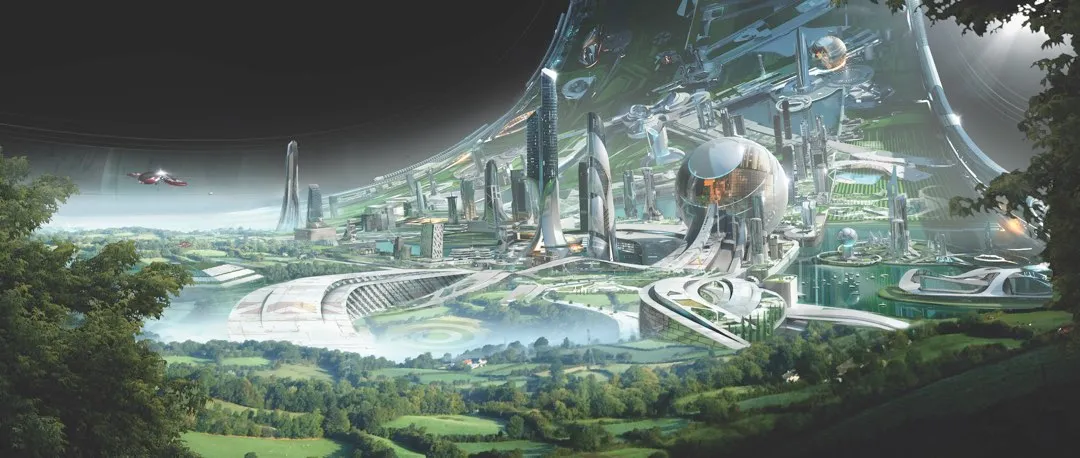Since Apollo 11, we’ve landed robots on Mars, built a base in orbit around the Earth, and sent probes beyond our Solar System. Here, sci-fi author Stephen Baxter speculates about what might be achieved in the next decade, and 30 years into the future, with illustrations by sci-fi artist Mitchell Stuart.
You can read the full feature, which explores our first steps on Mars (Part 2), first contact (Part 4), and how a space elevator would change the way we connect to the world beyond our atmosphere (Part 5), in the Summer issue of BBC Science Focus Magazine – subscribe here.
Part 1: The New Moon Race
The Decade of the Moon
2020-2029
In March 2019, US Vice President Mike Pence publicly challenges NASA to mount a crewed return to the Moon before the end of 2024. This would be the last year of a second term for President Trump, and so an echo of President Kennedy’s call for a Moon landing before the end of the 1960s, which led to the Apollo programme.
The NASA of the 2020s is not the young and nimble organisation of 1960. However, the challenge is accepted.
In fact, NASA, with its overseas partners, has already begun the development of a new lunar architecture. This depends on a heavy-lift launcher called the Space Launch System, which is a rival to the Saturn V; an Apollo-like spacecraft being developed with the Europeans; and the Lunar Gateway, a space station in lunar orbit, from which astronauts could descend to the surface. All that is missing is a lander, a new Lunar Module. But the private company Blue Origin steps up to the plate, with a design it has been developing since 2016.
And so the first lunar mission since Apollo launches in late 2024.

By now, however, the decade of the Moon is in full swing, with previous visits from automated landers and rovers launched by a variety of countries, including the Europeans, Japan, India, and – most ambitiously – China, which attempts sample-return flights. Still, it is believed that the majority of humankind watch or listen on 13 November 2024 – just inside Pence’s deadline – as NASA astronauts Jeff Krauss and Kaui Pukui begin their cautious descent towards the Mare Imbrium, the first lunar crew since Apollo 17…
In the year 2029, 60 years after Apollo 11, a Chinese crew lands on the surface, respectfully close to the site of the 2024 US landing attempt. The ‘Pence mission’ had always been premature. Krauss and Pukui were not the first to land on the Moon, but, six years after their disastrous descent, they are the first to be buried there.
Read more about space exploration:
- Who will be next to land on the Moon?
- Why we need to go back to the Moon
- Space mining: the new goldrush
Part 3: The Space Habitat
The Decade of Earth
2040-2049
The largest single colony off planet Earth is in orbit. Lagrange Station is situated at L4 – the fourth Lagrange point – a gravitationally stable location in the Moon’s orbit around Earth.
The central habitat, a squat, tuna-can-like cylinder, is all but lost in a wider infrastructure of support facilities: a solar sail for station-keeping, an extensive radiator farm, and ring-shaped mirrors that provide the habitat with sunlight. The interior of Lagrange is spectacular, with a farmed landscape curving up over the visitor’s head. But this is a place of work, for 10,000 people. It was from here that the first crewed Mars missions were launched.

Now, though, Lagrange’s main customer is not Mars but Earth. Led by such prestigious bodies as the Cambridge University Centre for Climate Management, founded in 2025, large-scale geoengineering initiatives are underway in an attempt to salvage Earth’s climate. Among them is ‘albedo manipulation’ – cooling the planet by reflecting or deflecting away some of the sunlight. By now, the tremendous orbital mirrors and lenses tended by Lagrange crews are themselves planetary in scale.
All this is controversial on Earth, because such solutions inevitably favour some nations over others. Amid rising sea levels, the desiccating tropics, and gathering migrant flows, there is a feeling of a slide to war.
Listen to episodes of the Science Focus Podcast about space:
- There is no Plan B for planet Earth – Lord Martin Rees
- The future of humanity – Michio Kaku
- Building a base on the Moon, and crafting believable sci-fi – Andy Weir
- What asteroids can tell us about our Solar System – Natalie Starkey
However the citizens of Lagrange are more concerned about their own politics, rather than Earth’s. Here, on the Moon, and even on Mars, debates are underway on the future of human rights. A confined colony in space will always be an intrinsically tyrannous environment, because all human life will depend on centrally controlled systems. Bluntly, a tyrant in control of the air supply would have the power of life and death.
A new constitution, called the Cockell Protocol, named after the astrobiologist Charles Cockell, is being drafted to ensure freedom and safety. It will be a new way of living, unimagined on the Earth – and yet, as many point out, with lessons for the inhabitants of that small world.
And on the Moon, at least, with the first children born there already in their teens, the right to freedom and self-governance is high on the agenda. This comes to a head in 2045, a century after the first use of atomic weapons in war. When the US attempts to set up a nuclear weapons site at its own Moon base, the lunar colonies – including the American ones – declare unilateral independence. A new nation is born, the first in space.
Follow Science Focus onTwitter,Facebook, Instagramand Flipboard